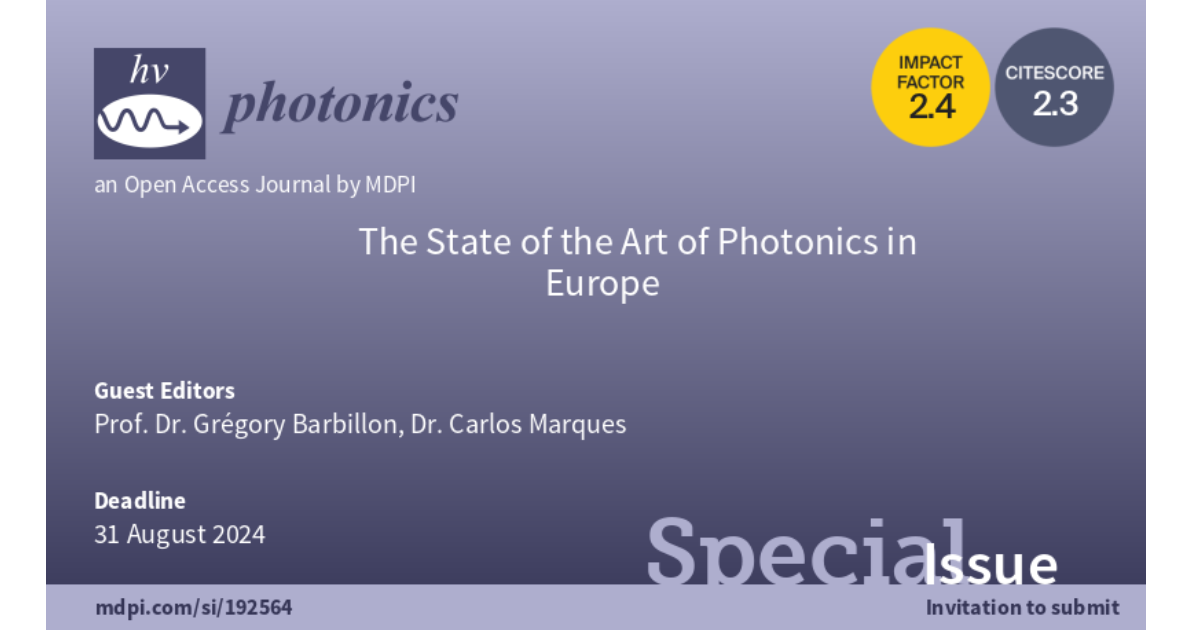The State of the Art of Photonics in Europe
A special issue of Photonics (ISSN 2304-6732).
Deadline for manuscript submissions: 31 August 2024 | Viewed by 1026

Special Issue Editors
Interests: plasmonics; nano-optics; non-linear optics; nanophotonics; condensed matter physics; optical sensing; biosensing; nanotechnology; surface-enhanced spectroscopies; sum-frequency generation spectroscopy; materials chemistry; physical chemistry; fluorescence
Special Issues, Collections and Topics in MDPI journals
Interests: photonics; optics for aerospace; optical sensors; optical devices; machine learning for optics
Special Issues, Collections and Topics in MDPI journals
Special Issue Information
Dear Colleagues,
Photonics is all around us. In a smartphone, a television or in a computer, we can find photonic cameras or photonic displays. In a printer, we can find a photonic scanner. In a home, we can also find photonic LED lighting and infrared photonic sensors of movement for protection. Thus, we can find photonics everywhere. In addition, we observe the same thing in industry. Indeed, we find photonic sensors that permit robots to see, from the apparatus of medical imaging, to the laser manufacturing of 3D components, lights for our cars, and communications through optical fibers and space in order to distribute data around the world. In summary, our present world simply works with photonics. Thus, in this Special Issue, we wish to address the latest advances in photonics located in Europe in all these fundamental and applied aspects. Therefore, it is with great pleasure that we invite you to submit a manuscript for this Special Issue. Full papers, communications, and reviews are all welcome.
Prof. Dr. Grégory Barbillon
Dr. Carlos Marques
Guest Editors
Manuscript Submission Information
Manuscripts should be submitted online at www.mdpi.com by registering and logging in to this website. Once you are registered, click here to go to the submission form. Manuscripts can be submitted until the deadline. All submissions that pass pre-check are peer-reviewed. Accepted papers will be published continuously in the journal (as soon as accepted) and will be listed together on the special issue website. Research articles, review articles as well as short communications are invited. For planned papers, a title and short abstract (about 100 words) can be sent to the Editorial Office for announcement on this website.
Submitted manuscripts should not have been published previously, nor be under consideration for publication elsewhere (except conference proceedings papers). All manuscripts are thoroughly refereed through a single-blind peer-review process. A guide for authors and other relevant information for submission of manuscripts is available on the Instructions for Authors page. Photonics is an international peer-reviewed open access monthly journal published by MDPI.
Please visit the Instructions for Authors page before submitting a manuscript. The Article Processing Charge (APC) for publication in this open access journal is 2400 CHF (Swiss Francs). Submitted papers should be well formatted and use good English. Authors may use MDPI's English editing service prior to publication or during author revisions.
Keywords
- photonic crystals
- nano-photonics
- plasmonics
- nano-plasmonics
- photonic devices
- plasmonic devices
- biophotonics






